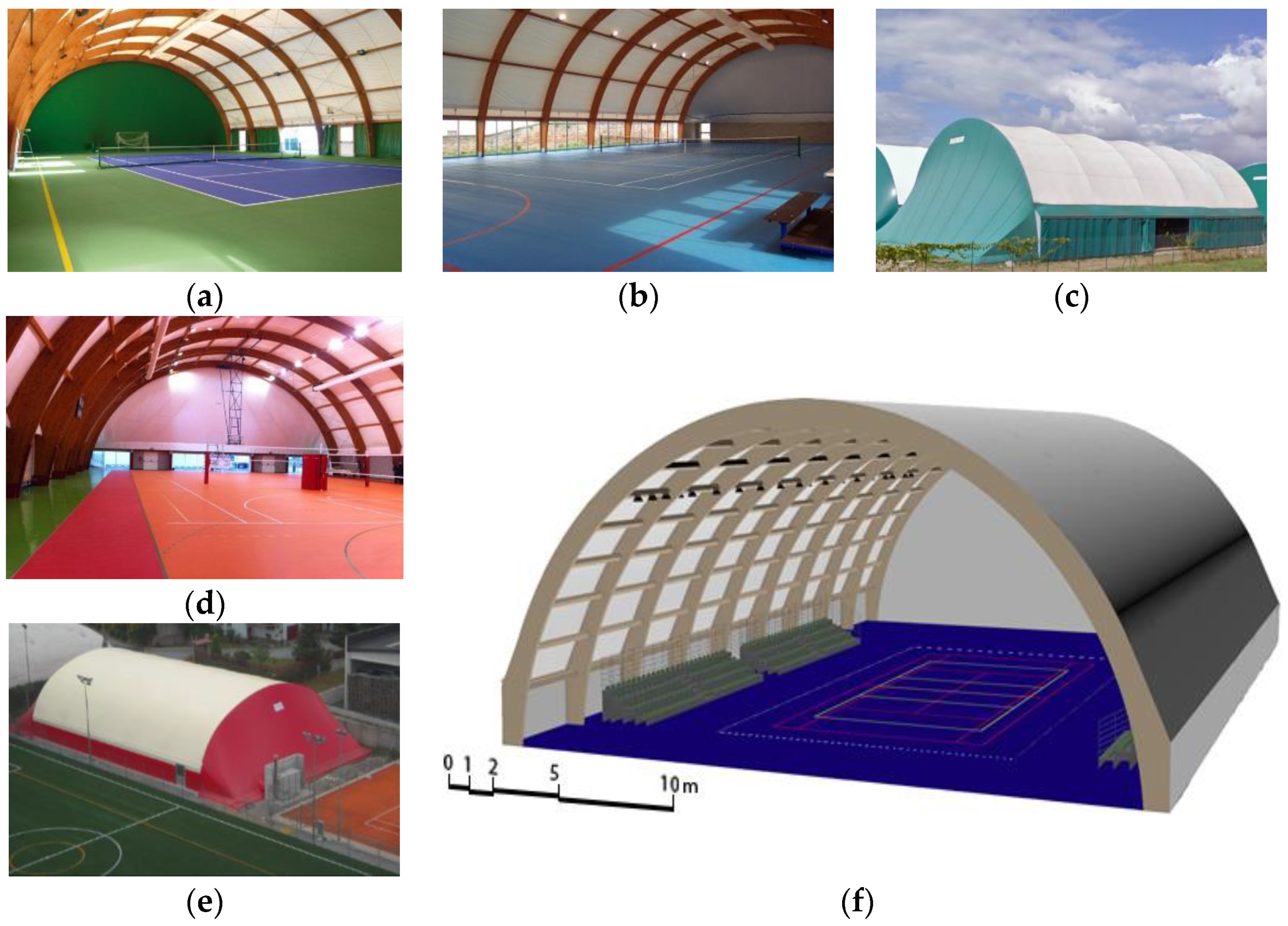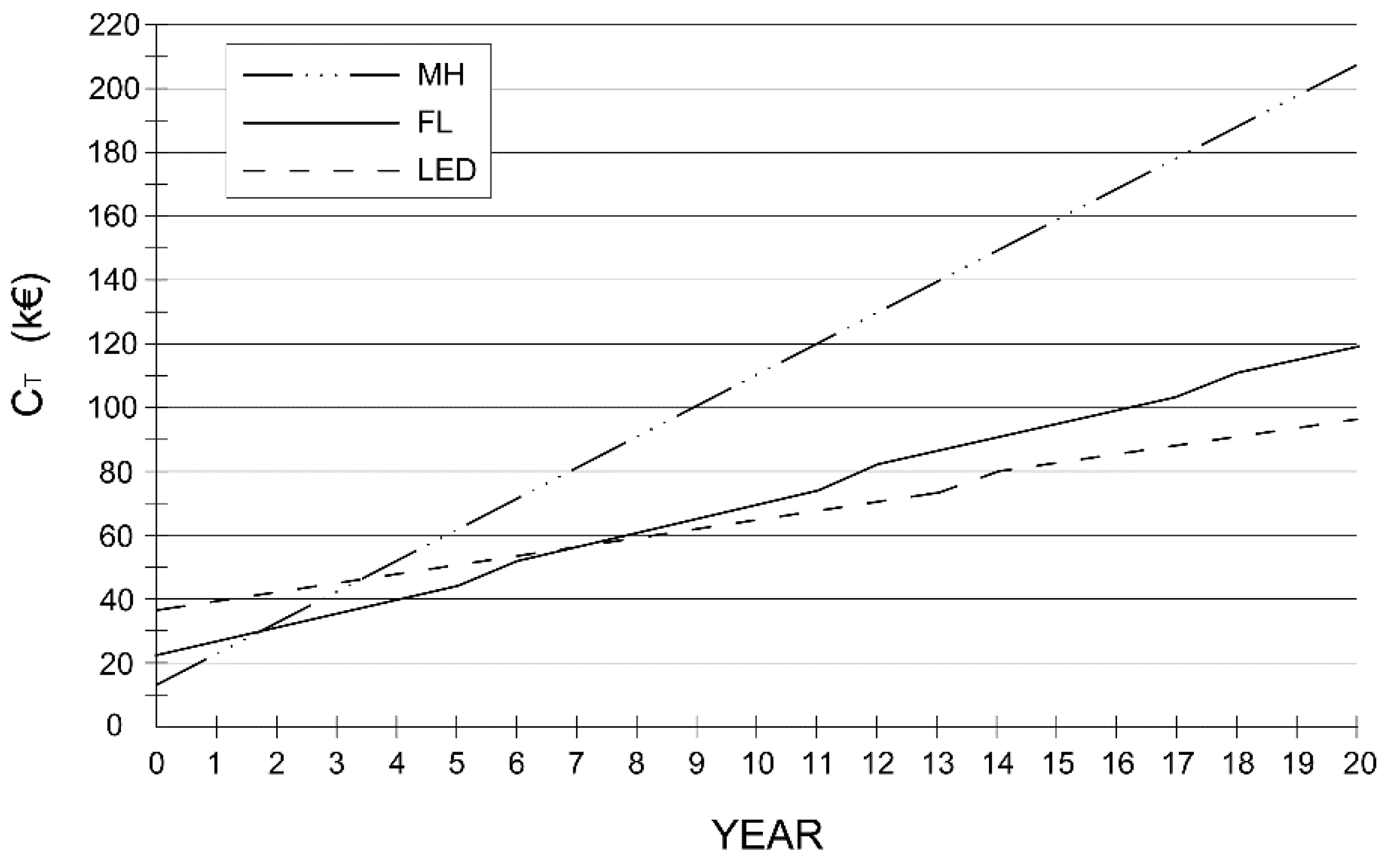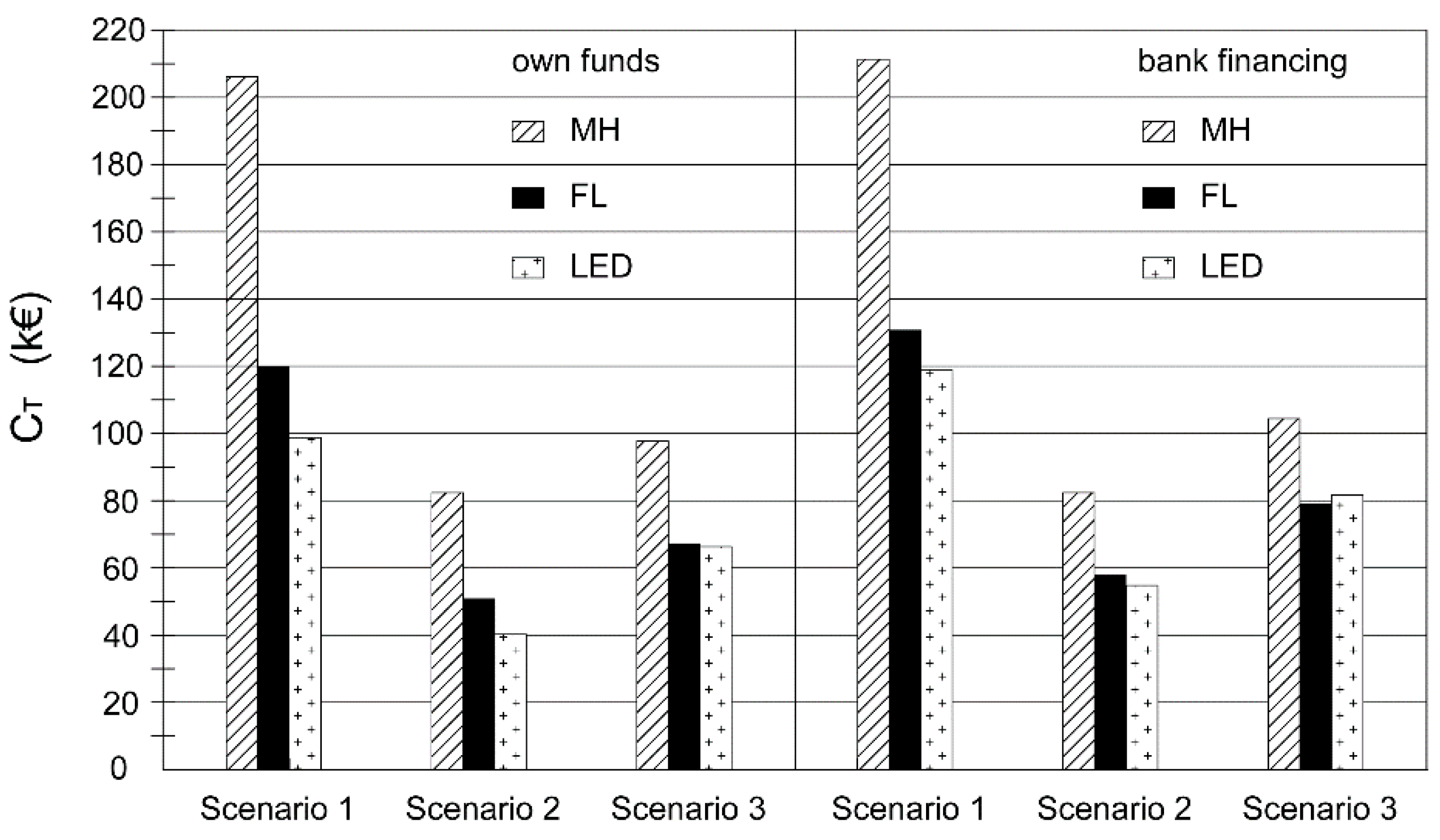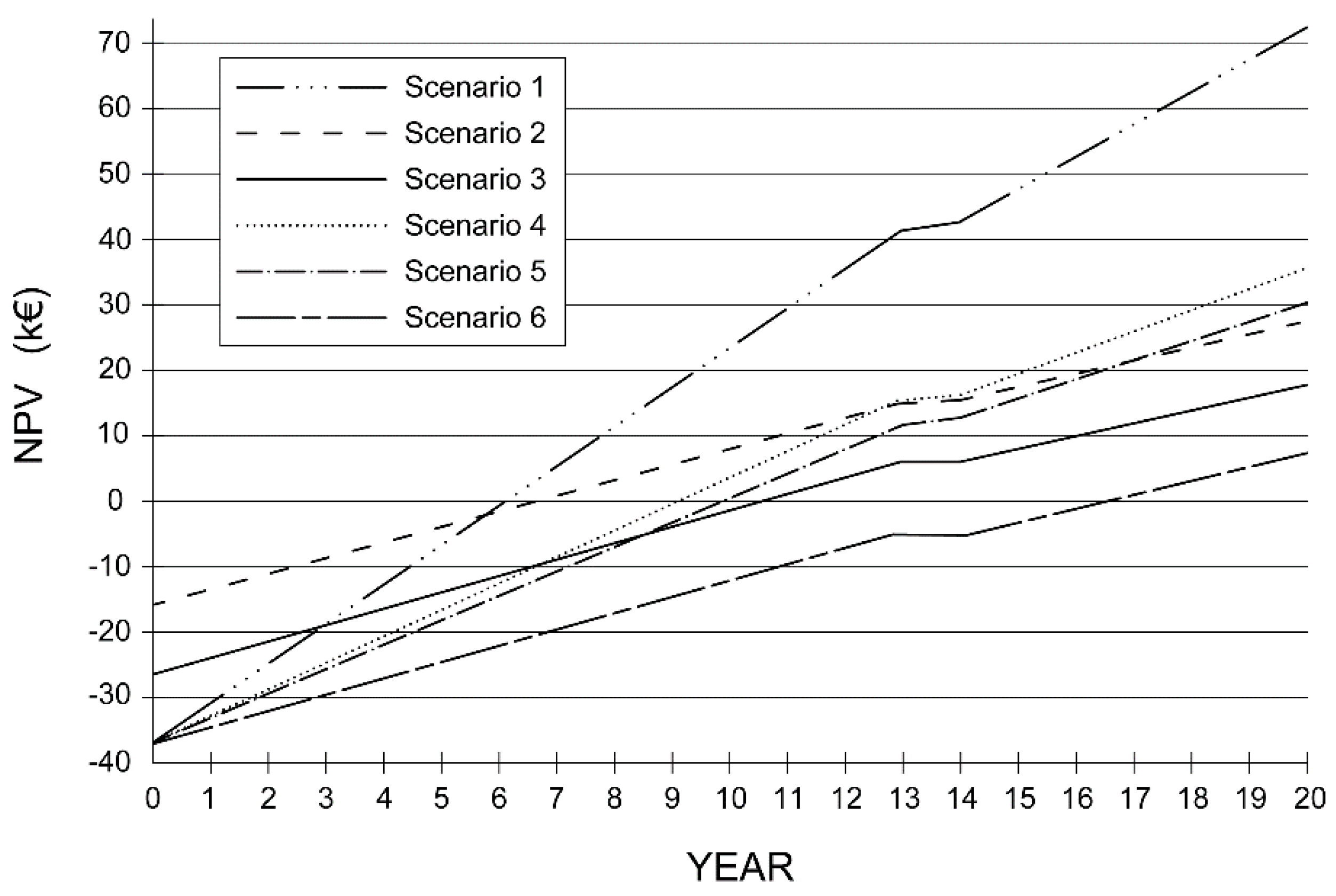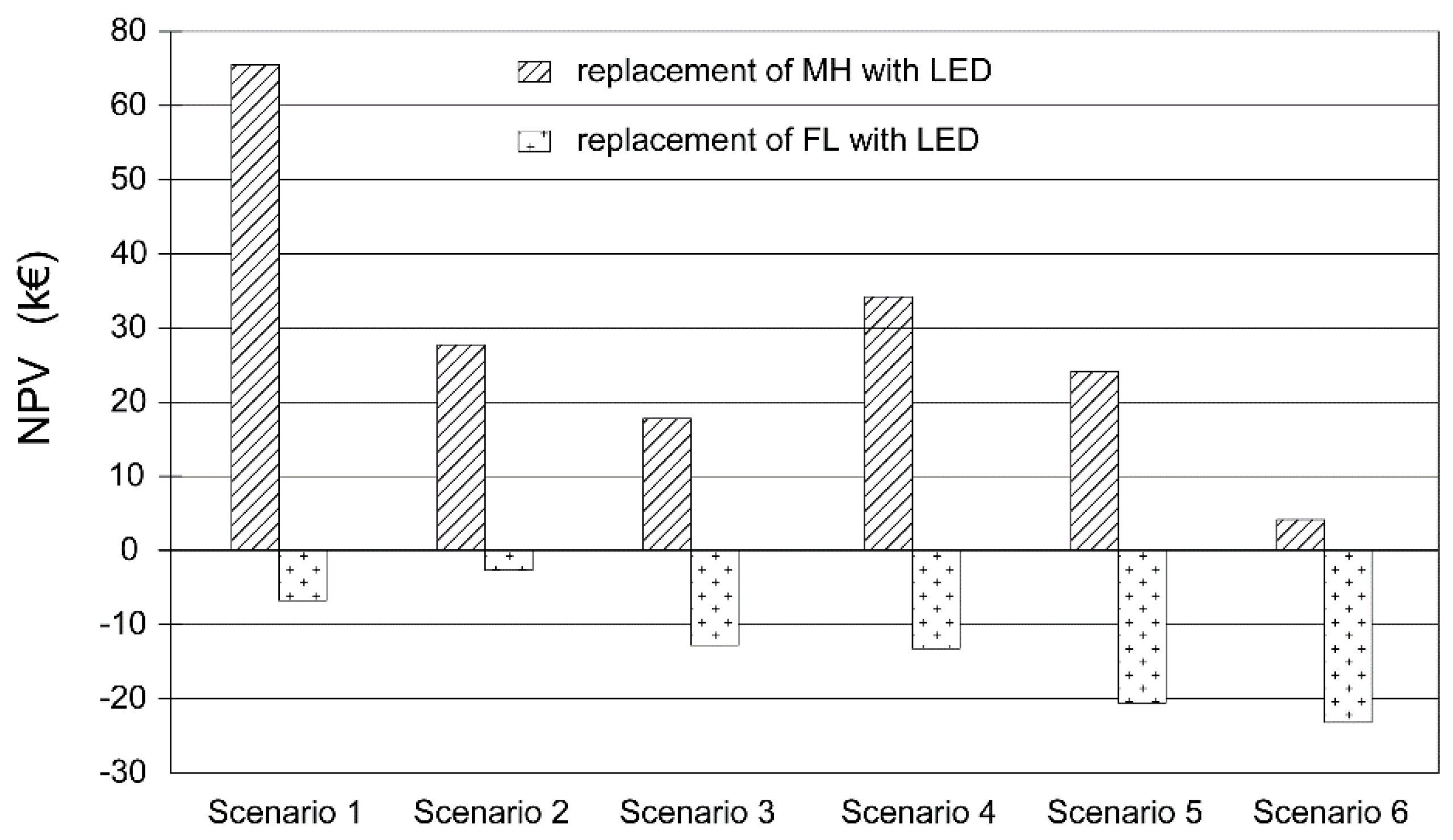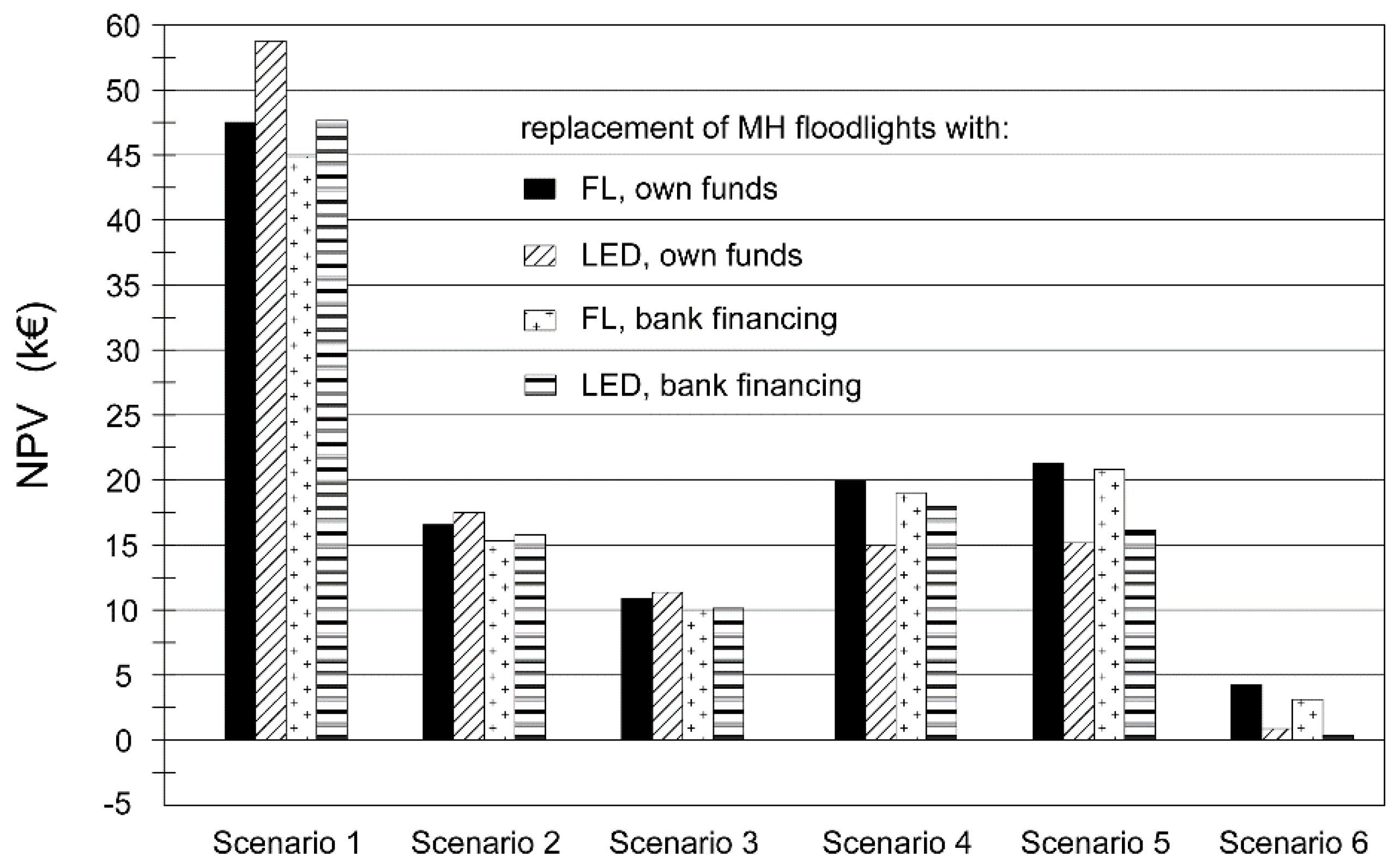The comparisons between the different lighting systems are addressed in this work on techno-economic standpoint. The economic analyses were conducted for a reference period of 20 years. Before introducing the results, it is necessary to provide information on the economic items considered for the calculation. For the three lighting systems were calculated: the initial investment cost (I
0), the operating cost (C
o), and the maintenance cost (C
m). The parameter I
0 is given by the product of the number of installed luminaires (N) and their unit cost. The comparisons were done considering the realization of the lighting system with: its own funds and a bank financing. In the first case, I
0 is placed to the year of realization of the lighting system, while in the second case the mortgage payment is considered in the annual outflows. The mortgage payments were calculated using a fixed rate equal to 3.5% [
35]. The parameter C
o is due to the energy consumptions when the lighting system is switched-on and it depends on: the electrical installed power for lighting (P), the usage time and the hourly rate of electrical energy (estimated at 0.18 €/kWh [
36] according to the Italian Regulation Authority for Electricity, Gas and Water). The parameter C
m depends on the frequency of the maintenance works for the luminaires, which are necessary in order to guarantee that the lighting requirements are satisfied (see
Table 1). This parameter was evaluated as International Commission on illumination (CIE) [
34]: C
m = N
r∙C
u, where N
r is the number of replaced lamps during the scheduled maintenance and C
u is the all-comprehensive unit cost of lamp (that takes into account the supply, installation and disposal costs usually applied in Italy). The frequency of the scheduled maintenance varies in function of the lamp type and it is equal to 1, 6 and 14 years respectively for MH, FL and LED. The determination of this frequency for each lamp is influenced by the lighting requirements, which need to be satisfied, and by the technical data about the lamp survival and lamp lumen maintenance factor provided by the manufacturers (see
Table 2). The frequency of the scheduled maintenance of 14 years for LED was determined considering conservatively an accidental failure of 10% of the installed LED floodlights at the 70% of the reference period (20 years) [
37]. C
o and C
m are referred to different years, respect to the year of the realization of the lighting system (base year). For this reason, they have to be reported to the base year by discounting procedure. The discounting procedure depends on discount rate (r). The discount rate is defined as the rate at which the investment revenues and costs are discounted in order to calculate its present value. For the realization of the lighting system with its own funds, a discount rate equal to 2% was considered [
38], while for the use of a bank financing, the discount rate assumes the same value of the interest rate (3.5%). The discounting of the individual cost parameter was done by using the following equation: C
d = C
k/(1 + r)
k, where C
d (€) is the discounted cash flow, C
k (€) is the cash flow expected in the k year and r is the discount rate.
In order to consider the different usages of the lighting system, according to the different lighting classes, multiple scenarios have been defined. Each scenario is characterized by a total annual usage time of the lighting system equal to 2000 h [
39] divided into smaller fractions of time, for which the lighting system is used to satisfy different lighting classes. The assumed scenarios are defined in
Table 4, where the total usage time and the usage times for each lighting class are indicated.
In order to evaluate the sustainability of the different lighting systems, the data contained in
Table 3 were used. In the following sections, two techno-economic evaluations are discussed: the first (
Section 4.1) is referred to the realization of the lighting systems in a sports hall of new construction, the second (
Section 4.2) is referred to the refurbishment of the lighting system in an existing sports hall.
4.1. Energy and Economic Analysis of the Realization of the Lighting System in a Sports Hall of New Construction
When the lighting system in a sports hall of new construction has to be realized, the total management cost of the lighting system (C
T) can be estimated as C
T = I
0 + C
o + C
m. In this paper, I
0, C
o, and C
m were calculated for all the defined scenarios and considering the three different type of luminaires (MH, FL, LED, see
Table 2).
Table 5 shows the calculation results for the scenarios 1, 2 and 3 and using a discount rate equal to 2%. The calculation results for scenarios 4, 5 and 6 are not reported because they are very similar to those of scenario 3. In the sixth column of
Table 5, the values of the normalized management cost C
m,n are reported. They were obtained dividing the values of C
m by the number of years between two consecutive scheduled maintenances. The values of C
m,n are useful in order to have an immediate comparison between the maintenance costs of the different systems, but in order to correctly applied the discounting procedure the values of C
m were considered in the calculation. The last column of
Table 5 reports the values of the primary energy consumption in tons of equivalent oil (toe). For the calculation of tons of equivalent oil, the Italian Regulation Authority for Electricity Gas and Water [
40,
41] gives the value of the conversion factor for the electrical energy into primary energy, estimated in 0.187 × 10
−3 toe/kWh.
Considering the values shown in
Table 5, the trends of C
T in function of time is shown in
Figure 2 for the scenario 1. From the trends of C
T it can be observed that the lighting system with MH, despite having the lower cost of initial investment (I
0 = 13.4 k€), reach at the twentieth year the higher value of C
T (209.6 k€, higher than 2.33 times the lighting system with LED and 1.75 times lighting system with FL). This behavior is caused by the high operating cost, due to high energy consumption, and the high maintenance cost.
The lighting system with LED is characterized by the maximum value of the initial cost (I
0 = 36.9 k€) and the related trend of C
T has a weak inclination from the horizontal axis, due to the reduced operating and maintenance costs. For this reason, the total management cost is the lowest among all (C
T = 97.5 k€). The lighting system with FL has an intermediate trend and reach, at the twentieth year, a total management cost higher than the lighting solution with LED. With reference to the total management cost of the solution with MH, the lighting system with LED allows a simple payback time (PBT) of the higher initial investment cost, equal to 3.5 years, while the lighting system with FL allows a PBT of 1.7 years (see
Figure 2).
In
Figure 3, for an immediate comparison of the obtained results, C
T values reached at twentieth year are reported for different scenarios, both in the case of realization of the lighting system by own funds and in the case of bank financing.
From the
Figure 3 it is possible to notice that the lighting system with MH, in all the analyzed cases and for all the considered scenarios, has the highest values of C
T and therefore a low economic sustainability. More difficult is the comparison between the lighting systems with LED and FL. Despite the clear differences in energy consumptions (see
Table 5), the C
T values, reached at twentieth year, of these two lighting systems does not present, for all the scenarios, economical differences with significant relevance, because the lighting system with LED has the lower operating and maintenance costs, but also an higher initial investment cost.
It is important to point out that the greater difference between the values of CT for lighting systems with MH and with LED is reached in the Scenario 1, which provides for the maximum use of the lighting systems. Obviously, increasing the exploitation of the artificial lighting (in terms of the product between the number of luminaires switched-on and the usage time), the lower operating and maintenance costs have a more significant influence on the value of CT. Higher is the use of the sports hall and more attractive is the use of a lighting system with LED.
4.2. Economic Analysis of the Refurbishment of the Lighting System in an Existing Sports Hall
In this section, the refurbishment of the lighting system in an existing sports hall is analyzed. Therefore, in addition to the initial investment, the operating and the maintenance costs, the benefits that can be achieved through the refurbishment of the system are taken into consideration from the economic point of view. The expected benefits were assessed in terms economic benefit for the electrical energy saving (B
o) during the analyzed period and for the different maintenance associated with the different type of lamps (B
m). For each evaluation, there are both the incoming and outgoing cash flows and it is possible to calculate the payback time (PBT) and the net present value (NPV) [
38]. The intervention of refurbishment is sustainable when NPV has positive values during the analyzed period. The following were considered: refurbishment of MH with LED (MH-LED), refurbishment of FL with LED (FL-LED), refurbishment of MH with FL (MH-FL).
The evaluations are carried out on the lighting systems able to meet the minimum lighting requirements fixed by the technical standards (see
Table 1). The economic analysis has carried out considering the 6 operating scenarios (see
Section 4,
Table 4) and a reference period equal to 20 years.
Table 6 shows the results obtained for the considered economic parameters for each scenario.
In
Figure 4, the trend of NPV in function of the time is shown, in the case of the refurbishment of MH with LED, realized with an investment by own funds. The economic benefit, linked to the refurbishment, is higher as much as the value of NPV is higher. The time for which NPV = 0 corresponds to the PBT. In the specific case, it is possible to note that the PBT varies from a minimum of 6 years (scenario 1) to a maximum of 16.5 years (scenario 6). The refurbishment of MH with LED is always profitable for each analyzed scenario, because the NPV value always assumes a positive value at twentieth year.
In
Figure 5, for in an immediate comparison of the obtained results, NPV values reached at twentieth year are reported for the different scenarios. In
Figure 5, it can be observed that the replacement of MH with LED can always be economically viable. The maximum benefit is achieved for the scenario 1, when the sports hall and the lighting system are exploited intensively (see
Section 4). For this scenario the reduced installed power of the LED, combined with their long life time, allows a significant reduction of the operating and maintenance costs, permitting to recover the initial investment cost in a short time and ensuring high benefits in economic terms (see also
Figure 4, scenario 1). In contrast, the replacement of FL with LED does not reach, for any scenario, positive NPV values, therefore it is not a recommended solution from an economic point of view. If a discount rate of 4% (instead 2%) is considered, the same trends are obtained.
In
Figure 6, NPV values reached in the twentieth year are reported for the replacement of MH floodlights with LED floodlights and with FL luminaires. From the observation of the
Figure 6, it can be noticed that the replacement of MH floodlights with LED floodlights, despite a sharp drop in energy consumption, shows situations (see Scenario 6) for which NPV slightly exceeds the null value. The replacement of MH floodlights with FL luminaires, which are characterized by positive values of NPV for all the analyzed scenarios, shows NPV values higher than those obtained for the refurbishment with LED floodlights.
